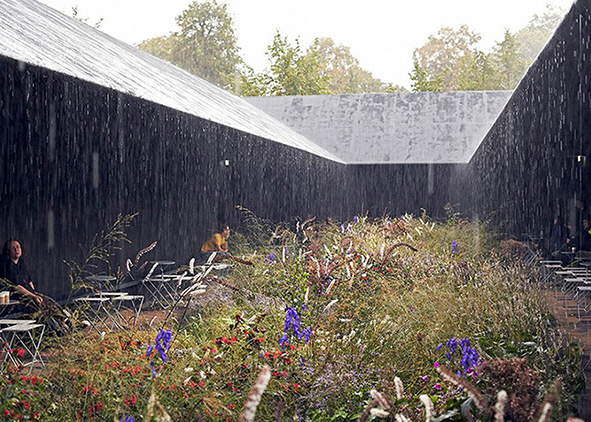Walking into the wild. A transition to a co-evolutionary landscape
DOI:
https://doi.org/10.19229/2464-9309/13112023Keywords:
wild, landscape, biodiversity, coevolution, vegetationAbstract
This research paper attempts to shift the approach and the possible attitudes of architectural and landscape design towards an interpretation of ecological transition based on the dimension of the ‘wild’, that is, on the possibility that the transformation of places by man contemplates other and the most diverse forms of life, spheres of proximity in which human activities give way to third and fourth natures, which develop their own habitats in an autonomous, dynamic and vital manner. In this reflection, thinking about a ‘landscape of the wild’ means thinking again about the relationship between human and natural habitats, which develops on many levels that cannot be reduced and simplified in the impending phenomenon of ‘rewilding’, ranging from the possibility of giving shape to the spaces of nature, of creating new forms of shared spaces between man and living things, to the conception of minimal architectures necessary to stimulate ancient human practices (such as walking) and which are capable of developing new ecologies.
Article info
Received: 23/03/2023; Revised: 25/04/2023; Accepted: 08/05/2023
Downloads
Article Metrics Graph
References
Atzeni, S. (2023), Passavamo sulla terra leggeri, Sellerio (ed. 2023), Palermo.
Balducci, F. and Camilli, B. (2022), “Progettare l’ecologia – Il vegetale come paradigma possibile di un’architettura sostenibile e resiliente | Designing ecology – The organic as a possible paradigm of a sustainable and resilient architecture”, in Agathón | International Journal of Architecture, Art and Design, vol. 11, pp. 89-93. [Online] Available at: doi.org/10.19229/2464-9309/1172022 [Accessed 17 April 2023].
Berque, A. (2021) Essere umani sulla terra – Principi di etica dell’ecumene, Memesis Kosmos, Sesto San Giovanni.
Careri, F. (2006), Walkscapes – Camminare come pratica estetica, Piccola Biblioteca Einaudi, Torino.
Clément, G. (2005), Manifesto del Terzo Paesaggio, Quodlibet, Macerata.
Dessì, A. and Mucelli, S. (eds) (2015), Paesaggi Lineari – Strategie e progetti per il recupero dei vecchi tracciati ferroviari del Sulcis-Iglesiente, Gangemi Editore, Roma.
Diderot, D. and Le Rond d’Alembert, J. B. (eds) (1778-1782), Encyclopédie ou Dictionnaire raisonné des Sciences des Arts et des Métiers par une societé de gens de lettres, Sociétés Typographiques de Lausanne et de Bernes.
Donadieu, P. (2006), Campagne Urbane – Una nuova proposta di paesaggio per la città, Donzelli editore, Roma.
Donadieu, P. (1999), “Sauvages dans la ville – De l’inventaire naturaliste à l’écologie urbaine – Bernadette Lizet, Anne-Elizabeth Wolf et John Celecia (textes réunis par)”, in Le Courrier de l’environnement de l’INRA, n. 38, pp. 120-121. [Online] Available at: hal.archives-ouvertes.fr/hal-01215684/ [Accessed 17 April 2023].
Donadieu, P. (1998), “Vers un rural postindustriel – Rural et environnement dans huit pays européens”, in Le Courrier de l’environnement de l’INRA, n. 34, pp. 129-130. [Online] Available at: hal.science/hal-01216060v1 [Accessed 17 April 2023].
Gausa, M. (2022), “Topologie verdi e paesaggi oltre il paesaggio – 30 anni di ricerche sulla ibridizzazione del verde | Green topologies and landscapes beyond the land – A 30-years research on green hybridization”, in Agathón | International Journal of Architecture, Art and Design, vol. 11, pp. 14-25. [Online] Available at: doi.org/10.19229/2464-9309/1112022 [Accessed 17 April 2023].
Gerritzen, H. and Oudolf, P. (2019), Planting the Natural Garden, Timber Press, Portland (US).
Illich, I. (2009), La perdita dei sensi, Libreria Editrice Fiorentina, Firenze.
Intini, E. (2019), “Più impollinatori, meno parassiti – Così la biodiversità migliora la resa dei raccolti”, in Focus.it, 16/10/2019. [Online] Available at: focus.it/ambiente/ecologia/giornata-mondiale-alimentazione-biodiversita-migliora-raccolti [Accessed 17 April 2023].
Myers, N. (2018), “How to grow livable worlds – Ten not-so-easy steps”, in Oliver-Smith, K. (ed.), The World to Come – Art in the Age of the Anthropocene, Samuel P. Harn Museum of Art, University of Florida, Gainesville, pp. 53-63. [Online] Available at: academia. edu/40441118/ How_to_grow_livable_worlds_Ten_not_so_easy_steps_2018_version_ [Accessed 17 April 2023].
Navarra, M. (2013), In Walk about City 2.0 – Architetture Geologiche e Faglie del Tempo, LetteraVentidue Edizioni, Siracusa.
Navarra, M. (2002), In Walk about City – Il paesaggio riscritto, un parco lineare tra Caltagirone e Piazza Armerina, Biblioteca del Cenide, Catania.
Oudolf, P. and Kingsbury, N. (2013), Planting – A New Perspective, Timber Press, Portland (US).
Perriccioli, M., Ruggiero, R. and Salka, M. (2021), “Ecologia e tecnologie digitali – L’architettura alla piccola scala come luogo di connessioni | Ecology and digital technologies – Small-scale architecture as a place of connections”, in Agathón | International Journal of Architecture, Art and Design, vol. 10, pp. 36-45. [Online] Available at: doi.org/10.19229/2464-9309/1032021 [Accessed 17 April 2023].
Rocca, A. (2021), Costruire Naturale, LetteraVentidue, Siracusa.
Rousseau, J.-J. (2016), Emilio. O dell’Educazione [or. ed. Émile ou De l’éducation, 1792], Edizioni Studium, Roma.
von Humboldt, A. (1810), Vues des Cordillères, et monumens des peuples indigènes de l’Amérique, F. Schoell, Paris.

Downloads
Published
How to Cite
Issue
Section
Categories
License
Copyright (c) 2023 Adriano Dessì

This work is licensed under a Creative Commons Attribution 4.0 International License.
This Journal is published under Creative Commons Attribution Licence 4.0 (CC-BY).
License scheme | Legal code
This License allows anyone to:
Share: copy and redistribute the material in any medium or format.
Adapt: remix, transform, and build upon the material for any purpose, even commercially.
Under the following terms
Attribution: Users must give appropriate credit, provide a link to the license, and indicate if changes were made; users may do so in any reasonable manner, but not in any way that suggests the licensor endorses them or their use.
No additional restrictions: Users may not apply legal terms or technological measures that legally restrict others from doing anything the license permits.
Notices
Users do not have to comply with the license for elements of the material in the public domain or where your use is permitted by an applicable exception or limitation.
No warranties are given. The license may not give users all of the permissions necessary for their intended use. For example, other rights such as publicity, privacy, or moral rights may limit how you use the material.


















































































